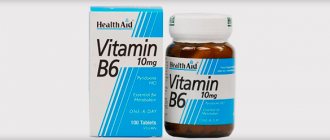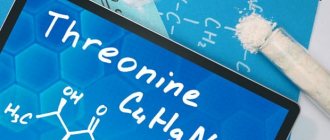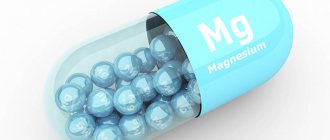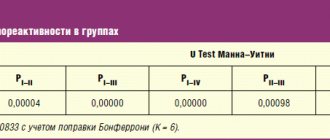Magne B6 for magnesium and vitamin B6 deficiency tablets No. 60
A country
Hungary
The country of production may vary depending on the batch of goods. Please check with the operator for detailed information when confirming your order.
Compound
1 tablet contains: magnesium lactate dihydrate 470 mg, pyridoxine hydrochloride 5 mg.
Excipients: sucrose - 115.6 mg, heavy kaolin - 40 mg, acacia gum - 20 mg, carboxypolymethylene 934 - 10 mg, talc (magnesium hydrosilicate) - 42.7 mg, magnesium stearate - 6.7 mg. Shell composition: acacia gum - 3.615 mg, sucrose - 214.969 mg, titanium dioxide - 1.416 mg, talc (magnesium hydrosilicate) - traces, carnauba wax (powder) - traces. White film-coated tablets, oval, biconvex, with a smooth shiny surface.
pharmachologic effect
Magnesium is a vital element that is found in all tissues of the body and is necessary for the normal functioning of cells and is involved in most metabolic reactions. In particular, it is involved in the regulation of the transmission of nerve impulses and muscle contraction. The body receives magnesium through food. A lack of magnesium in the body can be observed when the diet is disrupted, when the need for magnesium increases, or when there is an imbalance in the intake, metabolism and excretion of magnesium (for example, with increased physical and mental stress, stress, during pregnancy, when using diuretics). Pyridoxine (vitamin B6) is involved in many metabolic processes and in the regulation of nervous system metabolism. Improves the absorption of magnesium from the gastrointestinal tract and its penetration into cells. Serum magnesium content from 12 to 17 mg/l (0.5-0.7 mmol/l) indicates moderate magnesium deficiency; below 12 mg/l (0.5 mmol/l) indicates severe magnesium deficiency.
Indications for use
- established magnesium deficiency, isolated or associated with other deficiency conditions, accompanied by symptoms such as increased irritability, minor sleep disturbances, gastrointestinal cramps or rapid heartbeat, increased fatigue, pain and muscle spasms, and a tingling sensation.
Side effects
According to WHO, undesirable effects are classified according to their frequency of development as follows: very often (≥1/10), often (≥1/100, From the immune system: very rarely - allergic reactions, including skin reactions (urticaria, itching) From the digestive system: frequency unknown - diarrhea, abdominal pain.
Contraindications
- severe renal failure (CK - children under 6 years of age; - fructose intolerance, glucose-galactose malabsorption syndrome, sucrase-isomaltase deficiency; - simultaneous use of levodopa; - hypersensitivity to the components of the drug.
Use during pregnancy and lactation Clinical experience with the drug in a sufficient number of pregnant women did not reveal any adverse effects on the occurrence of fetal malformations or fetotoxic effects. Magne B6® can be used during pregnancy only if necessary and on the recommendation of a doctor. Magnesium passes into breast milk. Use of the drug during breastfeeding should be avoided feeding.
Use in children Contraindication: children under 6 years of age.
Mode of application
Before taking the drug, the patient should consult a doctor. The drug is taken orally with meals. The tablets should be taken with a glass of water. The daily dose should be divided into 2-3 doses. Adults are recommended to prescribe 6-8 tablets/day; children over 6 years old (body weight more than 20 kg) - 4-6 tablets/day. Treatment should be stopped after normalization of magnesium concentration in the blood.
special instructions
In case of severe magnesium deficiency or malabsorption syndrome, treatment begins with intravenous administration of magnesium preparations. Information for patients with diabetes mellitus: film-coated tablets contain sucrose as an excipient. If there is a concomitant calcium deficiency, it is recommended to correct the magnesium deficiency before taking calcium supplements or dietary supplements containing calcium. With frequent use of laxatives, alcohol, intense physical and mental stress, the need for magnesium increases, which can lead to the development of magnesium deficiency in the body. When using pyridoxine in high doses (more than 200 mg/day) for a long time (over several months or in some cases years), sensory axonal neuropathy may develop, which is accompanied by symptoms such as numbness, impaired proprioceptive sensitivity, distal tremor limbs and gradually developing sensory ataxia (impaired coordination of movements). These disorders are usually reversible and disappear after stopping vitamin B6. Use in pediatrics The drug in tablet form is intended only for adults and children over 6 years of age. For young children (over 1 year old), it is recommended to use the drug in the form of an oral solution. Influence on the ability to drive vehicles and operate machinery. No effect. There are no special recommendations.
Overdose
With normal kidney function, an overdose of magnesium when taken orally usually does not lead to toxic reactions. However, in case of renal failure, magnesium poisoning may develop. The severity of symptoms depends on the concentration of magnesium in the blood. Symptoms: decreased blood pressure, nausea, vomiting, central nervous system depression, decreased reflexes, ECG changes, respiratory depression, coma, cardiac arrest and respiratory paralysis, anuric syndrome. Treatment: rehydration, forced diuresis. In case of renal failure, hemodialysis or peritoneal dialysis is necessary.
Interaction with other drugs
Contraindicated combinations With levodopa: the activity of levodopa is inhibited by pyridoxine (unless taking this drug is combined with taking inhibitors of peripheral aromatic L-amino acid decarboxylase). Any amount of pyridoxine should be avoided unless levodopa is taken in combination with peripheral aromatic L-amino acid decarboxylase inhibitors. Not recommended combinations The simultaneous use of drugs containing phosphates or calcium salts may impair the absorption of magnesium in the intestine. Combinations that should be taken into account When using tetracycline antibiotics, it is necessary to maintain an interval of at least 3 hours between oral administration of tetracycline and Magne B6®, because Magnesium preparations reduce the absorption of tetracyclines.
Magnesium preparations are widely used in pediatric and neurological practice [1]. Some international journals (Swiss Magnesium and Magnesium and Trace Elements, English Magnesium Research) are entirely devoted to research into the role of magnesium in the human body under normal conditions and in various types of pathology, including disorders of the nervous system (epilepsy, stroke, migraine, cerebral palsy, etc. .d.) [2–5]. We previously reported on the use of magnesium preparations in psychoneurology and neuropediatrics in various clinical situations [6-8]. This article summarizes the experience of Russian and foreign researchers regarding the use of magnesium preparations in the treatment of patients with attention deficit hyperactivity disorder (ADHD).
In their daily work, pediatric neurologists often use the healing properties of vitamin B6 (pyridoxine). This is due to the fact that water-soluble vitamin B6 has pronounced properties as a metabolic stimulant and affinity for nervous tissue. In recent years, special attention of pediatric neurologists has been attracted by the possibilities of the combined use of a combination of magnesium and pyridoxine, which mutually complement and potentiate the beneficial effects of each other [9, 10]. This beneficial interaction is particularly sought after in the treatment of ADHD. We should not forget that magnesium and pyridoxine are conventional “tools” of neurodietology, and therefore are used in diet therapy for many types of nervous system lesions, including ADHD [10, 11].
ADHD
This condition remains relatively common among children over 5 years of age [12]. Attention deficit hyperactivity disorder is an etiologically heterogeneous group of behavioral disorders that leads to a decrease in quality of life. These behavioral disorders are expressed predominantly in decreased attention and hyperactivity, which can potentially lead to learning disorders (at school and/or college), as well as antisocial behavior [12].
Disorders of catecholamine metabolism are considered to be the main neurochemical substrate in the pathogenesis of ADHD. In ADHD, there are features of the cerebral metabolism of dopamine, serotonin and glucose, as well as morphometric features of brain structures (cerebellum, basal ganglia). Damage to the prefrontal-striato-thalamocortical structures of the brain of patients with ADHD has been described, as well as the involvement of descending projections of catecholamine and serotonergic neurons in the pathological process [12].
Genetic determination of ADHD is observed among 40–75% of patients, and environmental influences (endogenous and/or exogenous) are considered less significant. Psychosocial environmental factors appear to interact with genetic predisposition to ADHD, as well as abnormalities in neurochemical and neurophysiological parameters of the central nervous system, to cause biological damage [12].
Attention deficit hyperactivity disorder can occur with excessive consumption of sugar, industrially produced foods and drinks that contain large quantities of extractives, preservatives and dyes. Refined foods, high sugar and salt content contribute to increased elimination of magnesium from the body.
The main manifestations of ADHD are considered in the structure of three blocks of symptoms: attention deficit, hyperactivity, impulsivity. They can appear and change throughout the patient’s life [12].
Comorbid conditions with ADHD may include disturbances in emotional and motor control, paroxysmal conditions (epilepsy, restless legs syndrome), “comfort disturbances” (enuresis, migraine, irritable bowel syndrome, etc.), a tendency to substance abuse, tobacco smoking, alcohol consumption and narcotic substances. Upon reaching adolescence, ADHD is characterized by disorders with disruptive (destructive) behavior (oppositional defiant behavior, conduct disorders, antisocial behavior). Learning disorders in ADHD include dyslexia, dyscalculia, dysgraphia and dysortography, and communication disorders are expressed in disorders of phonation, expressive and receptive-expressive speech, and logoneuroses [12].
In the pharmacotherapy of ADHD abroad, central nervous system stimulants (methylphenidate, pemoline, dextroamphetamine), tricyclic and newer antidepressants (imipramine, desipramine, bupropion), the central α2-adrenergic stimulant clonidine and the anxiolytic buspirone are used. The newest drug for the treatment of ADHD is atomoxetine, the pharmacotherapeutic effect of which is based on pre- and postsynaptic modulation of dopamine and norepinephrine at the receptor level [12].
Non-drug treatments for ADHD include psychotherapeutic principles of behavior modification, biofeedback, differentiated learning strategies, and nutritional therapy. The latter occupies an intermediate position between drug and non-drug methods of treating ADHD. Some researchers tend to consider food allergies as one of the factors in the development of hyperactivity in children, and therefore the use of hypoallergenic diets leads to partial or complete correction of ADHD. It is not recommended to eat foods that may contain artificial flavors and colors, tea and carbonated drinks. When using hypoallergenic and oligoantigenic diets, patients with ADHD show improvement in a number of comorbid conditions (headache, irritable bowel syndrome, motion sickness). The Feingold low-salicylate diet is also known, which implies the need to exclude foods containing natural salicylates from the diet [12, 13].
The use of vitamins and minerals is a mandatory component of complex treatment of ADHD, providing modulation of cognitive deficits. O.A. Gromova et al. (2010) consider magnesium and pyridoxine preparations to be the basis of a nutritional approach to pathogenetic therapy of children with ADHD [14]. Pyridoxine is believed to improve behavioral responses.
Below we will look at some of the features and properties of magnesium, as well as pyridoxine.
Magnesium
This macroelement is a representative of the main subgroup of the second group of the third period in the periodic table of the chemical system (atomic number 12). If at birth only about 760 mg of magnesium is present in the human body, then by 4–5 months of age its content increases to 5 g, and by adulthood it reaches 25 g. Moreover, up to 30–40% of magnesium is found in muscles and soft tissues. tissues, 1% is in the extracellular fluid, and the rest (50–60%) magnesium is present in skeletal organs [11].
Magnesium regulates many physiological and biochemical processes and associated functions in the human body. By entering into reversible bonds with many organic substances, magnesium provides the ability to metabolize about 300 enzymes (including creatine kinases, adenylate cyclases, phosphofructokinases, K-Na-ATPases; enzymes of glycolysis, protein synthesis, transmembrane ion transport, etc.) [11].
A deficiency of magnesium, which is an antioxidant and calcium blocker, does not allow one to resist the effects of oxidative stress and other pathological phenomena that lead to significant damage to the endothelium and mitochondria. Therefore, magnesium content in physiological fluids and tissues of the human body influences numerous biochemical mechanisms, including the response of N-methyl-d-aspartate receptors to excitotor amino acids, cell membrane stability and viscosity, and the toxic effects of calcium [11].
Somatic manifestations of magnesium deficiency include increased blood pressure, a tendency to thrombus formation, cardiac arrhythmias, spastic contractions of the intestines, esophagus, apnea, bronchospasm, etc. Psychoneurological manifestations of magnesium deficiency include tremor, chorea-like movements, ataxia, skeletal muscle spasms, headaches and symptoms tetany, as well as increased excitability and anxiety. “Chronic fatigue” syndrome (weakness/malaise/decreased physical activity, etc.), decreased mental performance, weakened concentration and memory, headache, hearing loss, and less commonly, hallucinations are also characteristic [11].
Nutritional sources of magnesium include green leafy vegetables, whole grains, nuts, seeds, soybeans, seaweed, squid, bananas, as well as milk and dairy products. Excessive elimination of magnesium from the body is facilitated by the consumption of refined foods, salt and sugar [11].
Since the correction of obvious and latent magnesium deficiency through dietary consumption of this macroelement through food is difficult, magnesium preparations with a high level of utilization and proven clinical effectiveness are of particular importance. It should be remembered that magnesium is not produced in the body, and as a result can only be obtained from food, nutritional supplements or special medications [11].
The magnesium requirements of children of different ages (0–18 years) are presented in table. 1 [15]. It is believed that the need for this macronutrient increases slightly with physical and/or intellectual stress, as well as under the influence of stress factors.
Pyridoxine
This water-soluble vitamin occurs in foods in three forms: pyridoxine, pyridoxal, pyridoxamine (their biological activity is approximately equivalent). Pyridoxine is a coenzyme of proteins involved in the processing and transamination of amino acids, as well as a regulator of protein utilization [11].
Pyridoxine improves metabolism in brain tissue, increases its performance, and helps improve memory and mood. Pyridoxine deficiency is accompanied by disturbances in glutamine metabolism. The first signs of pyridoxine deficiency include behavioral and circulatory disorders, emotional disorders, numbness of the limbs, muscle hypotonia, hair loss, cracks in the corners of the mouth [11].
Food sources of pyridoxine include grain sprouts, walnuts, hazelnuts, spinach, potatoes, carrots, cauliflower and white cabbage, tomatoes, citrus fruits, cherries, strawberries, legumes, dairy and meat products, liver, eggs, and various cereals [11]. The norms of daily intake of vitamin B6 by children and adolescents are presented in table. 2 [15].
Magnesium and pyridoxine for ADHD
M. Mousain-Bosc et al. (2006) examined 40 children with ADHD who received a combination of magnesium and pyridoxine (magnesium - 6 mg/kg/day, pyridoxine - 0.6 mg/kg/day) for at least 8 weeks [16]. In addition to assessing ADHD symptoms themselves, the researchers assessed intraerythrocyte magnesium levels. It is noteworthy that patients with ADHD showed a statistically significant decrease in intraerythrocyte magnesium (compared to children in the control group, n = 36). In almost all cases, the described regimen of therapeutic use of magnesium/pyridoxine for at least 2 months was accompanied by a decrease in the manifestations of the disease (decreased hyperactivity and aggressiveness, improved attention during schoolwork); in parallel, a statistically significant increase in the values of intraerythrocyte magnesium content was noted. When the described therapy was stopped after several weeks, the children experienced a return of the original manifestations of ADHD, which was again accompanied by a decrease in magnesium in erythrocytes [16].
Many other researchers not only associate magnesium deficiency with aggravation of the severity of ADHD symptoms, but also suggest the role of deficiency of this macroelement in the etiopathogenesis of the disease in childhood [17–20].
The so-called restless legs syndrome, often accompanying ADHD, is a comorbid condition; Magnesium preparations are also used in its treatment (the effectiveness of which is beyond doubt from the standpoint of evidence-based medicine) [21].
When children with ADHD are prescribed the low-salicylate Feingold diet, the likelihood of them developing a deficiency in a number of minerals, including magnesium, increases significantly (due to the pronounced restrictiveness of this type of therapeutic diet), which requires appropriate subsidies of magnesium and other macro- and microelements [12, 13] .
S. Dolina et al. (2014) believe that ADHD is a pyridoxine-dependent condition [22]. Data obtained by these authors earlier when examining children with various forms of epilepsy allowed researchers to consider epilepsy as an inborn error in pyridoxine metabolism [23]. The presence of certain relationships between ADHD and epilepsy has led Israeli scientists to believe that a similar approach is possible for ADHD. To test this hypothesis, S. Dolina et al. (2014) conducted a study of a number of parameters of pyridoxal phosphate-dependent tryptophan degradation, obtaining data indicating a significant impairment of pyridoxine-dependent enzymes in children with ADHD. Pathological changes in the activity of pyridoxal phosphate-dependent enzymes led to profound disturbances in neurotransmitter systems in ADHD. The authors come to the following conclusion: if disorders of pyridoxine metabolism are the main biochemical disorders in ADHD, then long-term treatment with pyridoxine can be considered as a pathogenetically based replacement therapy for this condition. According to researchers, long-term therapy with pyridoxine completely normalizes the behavior pattern of ADHD without causing any serious side effects [23].
M. Mousain-Bosc et al. (2004, 2006) believe that the use of a combination of magnesium/pyridoxine is accompanied by a decrease in central nervous system hyperexcitability in children [16, 24]. The effectiveness of the use of magnesium/pyridoxine in the treatment of ADHD in children aged 6–12 years was previously reported by O.R. Nogovitsyn and E.V. Levitin (2006) [25]. According to them, after 30 days after the start of the described therapy, an assessment of the patients’ condition using a complex of clinical, neuropsychological and biochemical studies revealed a significant improvement in behavior, a decrease in the level of anxiety and aggression, an improvement in fine and gross motor skills, a decrease in the severity of synkinesis, an improvement in attention parameters, normalization of magnesium homeostasis and a tendency to normalize the content of electrolytes in the blood. Russian researchers obtained statistically significant differences in these parameters compared to children in the control group (p value at the level from <0.01 to <0.001) [25].
N.N. Zavadenko (2012) also recommends the use of magnesium/pyridoxine preparations in the treatment of ADHD, emphasizing that replenishment of magnesium deficiency should last at least 2 months [26].
It is no coincidence that the indications for the use of a combination of magnesium with pyridoxine, in addition to established magnesium deficiency, seizures, paresthesia, tachycardia, and gastrointestinal spasms, include increased psycho-emotional lability, sleep disturbances, increased fatigue and anxiety.
The emergence of new dosage forms of drugs that are a combination of magnesium/pyridoxine, intended for use in pediatric practice, should be strongly welcomed. In particular, in the Russian Federation, at present, in addition to film-coated tablets (in 1 tablet of magnesium lactate dihydrate - 470 mg, pyridoxine - 5 mg), as well as film-coated tablets (in each magnesium citrate - 618.43 mg, pyridoxine hydrochloride - 10.00 mg), a magnesium/pyridoxine preparation is available, produced in the form of an oral solution (each 10-ml ampoule contains magnesium lactate dihydrate - 186 mg, magnesium pidolate - 936 mg, pyridoxine hydrochloride - 10 mg) [27 ].
All of the listed dosage forms are successfully used in the treatment of ADHD in children and adolescents.









